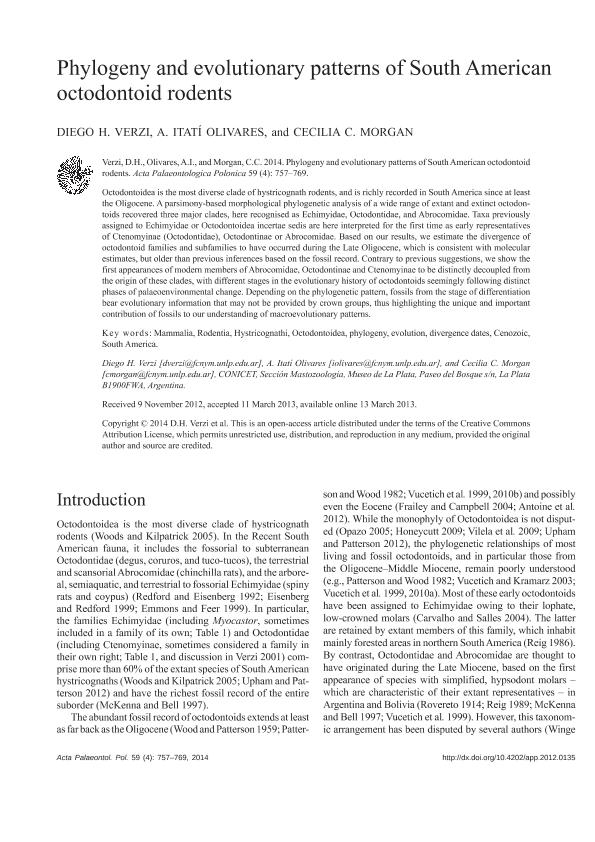Mostrar el registro sencillo del ítem
dc.contributor.author
Verzi, Diego Hector

dc.contributor.author
Olivares, Adriana Itati

dc.contributor.author
Morgan, Cecilia Clara

dc.date.available
2018-01-22T21:09:26Z
dc.date.issued
2013-03
dc.identifier.citation
Verzi, Diego Hector; Olivares, Adriana Itati; Morgan, Cecilia Clara; Phylogeny and evolutionary patterns of South American octodontoid rodents; Polish Academy of Sciences. Institute of Paleobiology; Acta Palaeontologica Polonica; 59; 4; 3-2013; 757-769
dc.identifier.issn
0567-7920
dc.identifier.uri
http://hdl.handle.net/11336/34195
dc.description.abstract
Octodontoidea is the most diverse clade of hystricognath rodents, and is richly recorded in South America since at least the Oligocene. A parsimony-based morphological phylogenetic analysis of a wide range of extant and extinct octodontoids recovered three major clades, here recognised as Echimyidae, Octodontidae, and Abrocomidae. Taxa previously assigned to Echimyidae or Octodontoidea incertae sedis are here interpreted for the first time as early representatives of Ctenomyinae (Octodontidae), Octodontinae or Abrocomidae. Based on our results, we estimate the divergence of octodontoid families and subfamilies to have occurred during the Late Oligocene, which is consistent with molecular estimates, but older than previous inferences based on the fossil record. Contrary to previous suggestions, we show the first appearances of modern members of Abrocomidae, Octodontinae and Ctenomyinae to be distinctly decoupled from the origin of these clades, with different stages in the evolutionary history of octodontoids seemingly following distinct phases of palaeoenvironmental change. Depending on the phylogenetic pattern, fossils from the stage of differentiation bear evolutionary information that may not be provided by crown groups, thus highlighting the unique and important contribution of fossils to our understanding of macroevolutionary patterns.
dc.format
application/pdf
dc.language.iso
eng
dc.publisher
Polish Academy of Sciences. Institute of Paleobiology

dc.rights
info:eu-repo/semantics/openAccess
dc.rights.uri
https://creativecommons.org/licenses/by-nc-sa/2.5/ar/
dc.subject
Hystricognathi
dc.subject
Octodontoidea
dc.subject
Phylogeny
dc.subject
Divergence Dates
dc.subject.classification
Meteorología y Ciencias Atmosféricas

dc.subject.classification
Ciencias de la Tierra y relacionadas con el Medio Ambiente

dc.subject.classification
CIENCIAS NATURALES Y EXACTAS

dc.title
Phylogeny and evolutionary patterns of South American octodontoid rodents
dc.type
info:eu-repo/semantics/article
dc.type
info:ar-repo/semantics/artículo
dc.type
info:eu-repo/semantics/publishedVersion
dc.date.updated
2018-01-15T17:36:40Z
dc.identifier.eissn
1732-2421
dc.journal.volume
59
dc.journal.number
4
dc.journal.pagination
757-769
dc.journal.pais
Polonia

dc.description.fil
Fil: Verzi, Diego Hector. Universidad Nacional de La Plata. Facultad de Ciencias Naturales y Museo. División Zoología de Vertebrados. Sección de Mastozoología; Argentina. Consejo Nacional de Investigaciones Científicas y Técnicas; Argentina
dc.description.fil
Fil: Olivares, Adriana Itati. Universidad Nacional de La Plata. Facultad de Ciencias Naturales y Museo. División Zoología de Vertebrados. Sección de Mastozoología; Argentina. Consejo Nacional de Investigaciones Científicas y Técnicas; Argentina
dc.description.fil
Fil: Morgan, Cecilia Clara. Universidad Nacional de La Plata. Facultad de Ciencias Naturales y Museo. División Zoología de Vertebrados. Sección de Mastozoología; Argentina. Consejo Nacional de Investigaciones Científicas y Técnicas; Argentina
dc.journal.title
Acta Palaeontologica Polonica

dc.relation.alternativeid
info:eu-repo/semantics/altIdentifier/doi/http://dx.doi.org/10.4202/app.2012.0135
dc.relation.alternativeid
info:eu-repo/semantics/altIdentifier/url/https://www.app.pan.pl/article/item/app20120135.html
dc.relation.alternativeid
info:eu-repo/semantics/altIdentifier/url/http://www.bioone.org/doi/abs/10.4202/app.2012.0135
Archivos asociados
